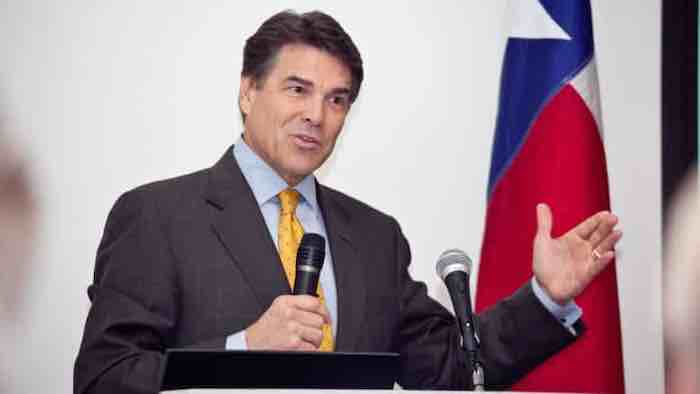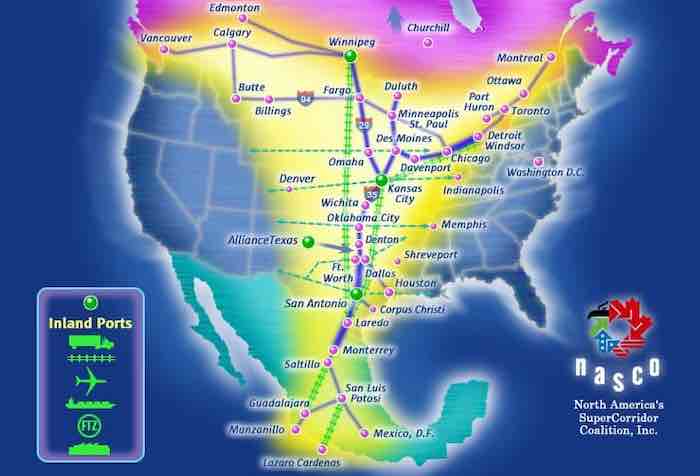By Patrick Wood ——Bio and Archives--May 10, 2019
American Politics, News | CFP Comments | Reader Friendly | Subscribe | Email Us
 Ex-Governor of Texas Rick Perry was appointed Secretary of Energy by President Donald Trump on March 2, 2017.
Even though President Trump has withdrawn from the Paris Climate Accord on global warming, apparently Secretary Perry has not gotten word, for the Department of Energy's web page on Climate Change is still present on the Energy.gov website, which prominently states,
Ex-Governor of Texas Rick Perry was appointed Secretary of Energy by President Donald Trump on March 2, 2017.
Even though President Trump has withdrawn from the Paris Climate Accord on global warming, apparently Secretary Perry has not gotten word, for the Department of Energy's web page on Climate Change is still present on the Energy.gov website, which prominently states, Addressing the effects of climate change is a top priority of the Energy Department. As global temperatures rise, wildfires, drought, and high electricity demand put stress on the nation’s energy infrastructure. And severe weather — the leading cause of power outages and fuel supply disruption in the United States — is projected to worsen, with eight of the 10 most destructive hurricanes of all time having happened in the last 10 years. To fight climate change, the Energy Department supports research and innovation that makes fossil energy technologies cleaner and less harmful to the people and the environment. We’re taking responsible steps to cut carbon pollution, develop domestic renewable energy production and win the global race for clean energy innovation. We’re also working to dramatically increase the efficiency of appliances, homes, businesses and vehicles.The Climate Change page presents a map of "How Climate Change Threatens America's Energy Infrastructure in Every Region." Then it displays a globe with the heading, "Energy Exascale Earth System Model" (E3SM) and explains that,
E3SM is a modeling, simulation, and prediction project that optimizes the use of DoE laboratory resources to meet the science needs of the nation.Even in light of this, it is still puzzling to some why the world's most powerful supercomputer is being created by the DoE to realize the "full potential of AI." According to an article in The Next Web,
The US Department of Energy (DoE) has announced it’s setting aside $600 million to build the world’s fastest supercomputer called Frontier. It will be jointly developed by AMD and Seattle-based supercomputer specialist Cray. The Frontier supercomputer will be capable of completing more than 1.5 quintillion calculations per second, and will join Aurora to become the second of the two exascale systems planned by US DoE for 2021.This must somehow be reconciled to the DoE's very simple Mission Statement also displayed on its website: The mission of the Energy Department is to ensure America’s security and prosperity by addressing its energy, environmental and nuclear challenges through transformative science and technology solutions. Certainly the Frontier project is "transformative", but why on earth does the DoE need the fastest AI computer in the world? And, what does it intend to do with it? Enter Smart Grid. We know from the above that the DoE is "working to dramatically increase the efficiency of appliances, homes, businesses and vehicles." The continuous and personal data stream collected from the nation's grid is the perfect input for such an AI super-computer to control the whole system from a single location. When President Obama (a Democrat) unleashed the Smart Grid program in 2009, the goal of micro-managing the country's energy usage was in plain view, and it soon may be finally realized in practice, with Secretary Rick Perry (a Republican ) taking the credit. The origin of the entire Smart Grid concept is found in the DoE's Bonneville Power Administration (BPA), created in 1937 and located in Pacific Northwest. Historically, the BPA was saturated with early Technocrats because of its deep involvement with hydroelectric power. In the early 1990s, the BPA took credit for having coined the term, "Energy Web", which later became "Smart Grid". The 1934 Technocracy Study Course, principally authored by Technocracy, Inc. co-founder M. King Hubbert, clearly specified control over energy in its seven-point requirements list:
Support Canada Free Press


Governor Rick Perry wrote Transportation Commission Chairman John W. Johnson on January 30, 2002 to outline his vision for the Trans Texas Corridor. The governor asked the three-member commission to assemble the Texas Department of Transportation’s top talent to create and deliver a Trans Texas Corridor implementation plan in 90 days.This is the same Rick Perry who today, as Secretary of Energy, is attempting to build the world's fastest super-computer to realize the "full potential of AI." Although Frontier will undoubtedly be shared with other government agencies, NGOs and private researchers, Technocrats within the DoE will have the ultimate tool to assert total control over all energy converted and consumed in the United States.
View Comments
Patrick Wood, Technocracy.News is an author and lecturer on elite globalization policies since the late 1970s. He is co-author with the late Antony C. Sutton of <em>Trilaterals Over Washington, Volumes I and II. His latest book, Technocracy Rising: The Trojan Horse of Global Transformation, focuses on the role of science and technology in the quest for global domination, and the elite who are perpetrating it.
Please attribute this article to Patrick Wood at Technocracy.News </em>